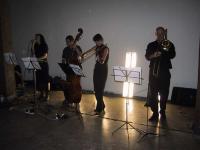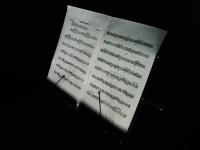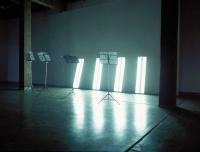Quartet for Voice, Trombone, Cello, and Seismograms
Composer Andrew Michael
http://quake.usgs.gov/~michael/
Earthquake Quartet #1 is a concept piece that attempts to express two
ideas about earthquakes. In its initial section, we hear a musical description of the earthquake cycle. In this cycle the motion of
tectonic plates slowly builds up strain in the earth's crust and this strain is then suddenly released during earthquakes. The latter
part of the piece is based on the idea that society and culture, including music, takes place with the earthquakes as an often-ignored
backdrop. However, geologic processes are an intrinsic part of our existence and ignoring the slow cycle described in the initial
section will have its consequences.
I composed this two-minute piece during November and December, 1999, following the devastating earthquakes in Turkey and
Taiwan. It had its premiere at a lecture titled The Music of Earthquakes on December 16 at Moscone Hall in San Francisco as part
of the annual Fall meeting of the American Geophysical Union. The musicians at the premiere were: soprano and USGS
Geophysicist Stephanie Ross, cellist and Stanford University Geophysics Graduate Student David Schaff, and myself, USGS
Geophysicist Andrew Michael, on trombone. The seismograms are audible because we have sped them up 80- to 100-fold so that
the frequencies are now in our hearing range.
The unusual mix of instrumentation is based on the birth of this work, which is an outgrowth of The Music of Earthquakes lecture
that I have been giving since 1997. This lecture mixes performance and lecture, music and science, acoustic instruments and
computer-generated sounds. A musician controls the source of the sound and the path it travels through their instrument in order
to make sound waves that we hear as music. An earthquake is the source of waves that travel along a path through the earth until
reaching us as shaking. It is almost as if the earth is a musician and people, including seismologists, are the audience who must try to
understand what the music means. By listening to both music and the audio playbacks of the earth shaking, we explore this analogy
and find new ways to learn about the earth, earthquakes, musical instruments and music.
Several times, members of the audience pointed out that I was using music to help explain scientific principles but had not included
the seismic sounds in any of the music. The quartet closes this loop and has allowed me to use our scientific data, as a musician, in
order to express my feelings, as a seismologist, about the relationship of society to earthquakes.
The earthquakes are the 1992 magnitude 7.3 Landers earthquake in southern California as recorded at Parkfield, California This is
the large rumble heard near the beginning. The repetitive four beat pattern is made up of two earthquakes both of which occurred at
Parkfield. On beats 1 and 3 you hear a magnitude 2 earthquake recorded on two stations only a couple of kilometres away. On beats
2 and 4 you hear a magnitude 5.1 event recorded about 10 kilometres away and 120 kilometres away near Hollister, California. Here,
the fourth beat is the slower moving S wave while the pickup to the fourth beat is the faster moving P wave. Listeners, especially
cellists and/or trombonists, may recognize that one theme from the second section is a rhythmically distorted quote from the
Allemande of Bach's second suite for solo Cello which is then further inverted and modified.
Some Playing Instructions
In the opening section the musicians are instructed to stop playing when large earthquakes occur. Once the earthquakes
become rhythmic, the musicians are to take the rhythmic character from the quakes and the challenge is to maintain the
inflexible tempo set by the audio track rather than the usual ebb and flow that is possible when playing with other musicians.
At the end, the musicians are told once again to stop when the large earthquake occurs but their parts do not actually show
them when this happens. It is supposed to be a surprise.
Andy Michael, Seismologist, USGS
___________________________________________________________________________________
Download mp3 File of Actual Performance Recording (5975mb)



Andrew Michael's Earthquake Quartet #1 was performed for the opening of Seismonitor on the 10th January, 2002, by Sydney based musicians Inga
Liljestrom(vocals), Natasha Rumiz (Viola), Michael Lira (Double Bass) and Simon Bartlett (Trombone). The score was slightly adapted
for this performance as the Cello part was replaced by Viola and Double Bass.